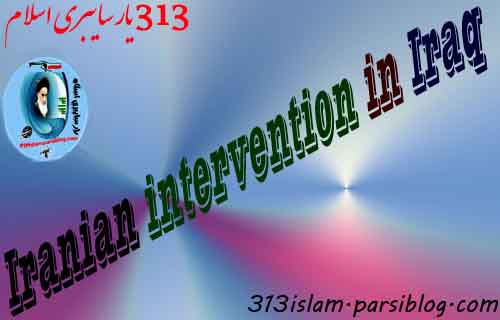» Iranian intervention in Iraq

Strategy and tactics
Tehran"s strategic objectives in its intervention in Iraq include keeping Iraq"s allied Shia-led government in power and stabilizing its own border.[28][29]
Iran has attempted to limit its overt military involvement in Iraq as a strategy geared toward avoiding the polarization of Iraq"s Sunni minority, creating popular backlash against Iran among Iraqis, or deepening sectarian tensions.[29] Most Iranian aid has thus far come in the form of technical assistance, the commitment of special forces troops, and air support. Iranian Brigadier-General Massoud Jazayeri stated that Iran could best help Iraq by providing it direction on its "successful experiments in popular all-around defense" that included "mobilizing masses of all ethnic groups."[30] Iran believes cooperation and unity among Iraq"s fractious militias is essential in its battle against ISIL.[28] Ali Khamenei, in remarks delivered on September 15, 2014, credited "the people of Iraq, the Iraqi Armed Forces and the popular forces" for halting the ISIL advance of the previous summer.[31]
The Washington Post reported Iran has sent more than 1,000 military advisers to Iraq, airstrikes and spent more than $1 billion on military aid.[32]
**>**>
Timeline
June 2014
In the week of 14 June, according to The Guardian, Iran"s Qods Force commander Qassem Suleimani was in Baghdad to organize an Iraqi counterattack against ISIL.[2] Press agency Reuters believes that since mid-June, Iran has members of its Army of the Guardians of the Islamic Revolution (IRGC) fighting on the ground in Iraq against ISIL, though it does not give an estimate of their numbers.[33]
According to Iranian social media, ISIL troops on June 19 attacked two Iranian border guards near Iran’s border city of Qasre Shirin, but this has not been confirmed by authoritative sources.[34]
American war correspondent David Axe on his website ‘War is Boring’ asserted that on 21 June 2014 “it appears Iran joined the air war” of Iraq and Syria against ISIL.[35]
By the end of June, according to American officials, Iran had established a control center at Al-Rasheed Air Base in Baghdad and was flying a small fleet of Ababil drones over Iraq, and an Iranian signals intelligence unit had been deployed at the airfield to intercept electronic communications between ISIL fighters and commanders.[36]
July 2014
On 1 July, according to IISS, several Su-25 aircraft were sent by Iran to al-Rashid and, later, to al-Muthanna air base.[37] The aircraft were supported by bi-national Iranian/Iraqi ground crews who had been trained in Iran.[15] (During the 1991 Gulf War, seven Su-25s had been flown by the Iraqi air force to Iran as a temporary safe haven and Iran had kept them since; ironically, some of them may now have returned to Iraq.[37])
On 5 July, Qods Force pilot Shojaat Alamdari was killed in Samarra, probably working there as a forward air controller.[15]
August 2014
Iraqi Kurdish President Barzani and Iranian foreign minister Zarif said, end of August 2014, that Iran had been the first country to provide weapons and ammunition (at unspecified date) to the Iraqi Kurdish forces (Peshmerga). Zarif said that Iran cooperated militarily with the Iraqi central government and the Kurds, but that it had “no military presence in Iraq”.[1]
In contradiction to that Iranian denial, Business Insider, without naming its sources, contends that in early August, Iran"s IRGC sent Quds Force personnel, attack aircraft and drones to Iraq, and that since early August Iran was operating its Su-25 aircraft (see July 2014) in combat against ISIL.[15]
But early August, Qasem Soleimani, chief of the Iranian Quds Force, was indeed in Erbil advising Kurdish forces, an Iranian official admitted early October 2014.[38]
On August 21–22, according to Kurdish sources, hundreds of Iranian soldiers, allegedly from Iran"s 81st Armored Division,[39] helped Peshmerga to take back Jalawla in Diyala Governorate from ISIL. Iran subsequently denied any military presence in Iraq.[40]
There were unconfirmed reports of clashes between ISIL forces and Revolutionary Guard Corps units near Urmia on August 28.[41]
Between August 31 and September 1, the Iranian-backed Iraqi Shia militias Asa"ib Ahl al-Haq and Kata"ib Hezbollah (see section Background) joined an Iraqi army and Kurdish Peshmerga assault to break the ISIL siege of Amerli in Saladin Governorate. The attack was supported by the U.S. Air Force at the request of the Iraqi army, according to a statement by the U.S. Central Command.[3][42]
September 2014
By early September, according to Business Insider, Iranian Qods Force personnel were deployed to Samarra, Baghdad, Karbala, and the former U.S. military post known as Camp Speicher.[15]
In late September, Iranian general Ahmad Reza Pourdastan threatened to "attack deep into Iraqi territory" should ISIL forces approach the Iranian border.[43] Earlier in the month, the Iranian government announced it had arrested Afghan and Pakistani nationals attempting to "cross Iran" to join ISIL.[44]
There have been sporadic reports of ISIL troops in Iranian Kurdistan, these claims are unverified.[45]
October 2014
Iranian general Qasem Soleimani, chief of the Iranian Quds Force, was reportedly present on the battlefield during Operation Ashura. Early October, Islamic Republic of Iran News Network (IRINN) published a picture of Soleimani, purportedly on some battlefield alongside Kurdish Peshmerga.[38] The Operation Ashura included Shi"ite paramilitary groups such as Asa"ib Ahl al-Haq, Kata"ib Hezbollah and the Badr brigades along with their leader Hadi Al-Amiri. Hezbollah was also present to provide technical advice and combat support for the allied offensive against the town of Jurf al-Sakhr.[46]
November 2014
On November 14, it was reported that the army had taken full control of Baiji, forcing ISIL forces to withdraw, and on 18 November, the anti-terrorism force Mosul Battalion entered the refinery for the first time since June. However, this could not be confirmed independently. If confirmed, it would be a major victory for Iraqi forces. State television said that they had entered the gates of the refinery.[47] Meanwhile, it was confirmed that Iraqi forces were in full control of Baiji. Iraqi state television said Baiji"s recapture was a "Graveyard for ISIS".[48] Later, the US Department of State congratulated the Iraqi forces for retaking the country"s largest oil refinery, confirming the Iraqi victory.[49]
At the end of November, according to Israeli website Haaretz, Al Jazeera broadcast video showing Iranian F-4 Phantom jet-fighters bombing ISIL targets in northeastern Iraq, though Al Jazeera in its report alleged they were "Iraqi jet-fighters".[50] US rear Admiral John Kirby affirmed on 3 December that he had "indications that [Iran] did indeed fly air strikes with F-4 Phantoms" targeting ISIL positions in the eastern Iraqi province of Diyala.[51]
December 2014

On 27 December, Iranian IRGC Brigadier General Hamid Taqavi was killed in Samarra, Iraq, reportedly by an ISIL sniper.[52] He is the highest ranking Iranian military official to die in Iraq since Iran"s military intervention began.[53]
March–April 2015
On 2 March, Qasem Soleimani, commander of the Iranian Quds Force, was directing Shia militia operations on the eastern flank during the surrounding of ISIL fighters, and was reportedly taking a leading role in the fighting of Iraqi forces and Shia militias against ISIL.[54][55]
Jim Phillips of the American The Heritage Foundation in March described Suleimani’s role in this war as: “he’s Iran’s viceroy for Iraq”.[56]
May 2015
American news website The Long War Journal states without revealing its sources that Iran has sent IRGC and Basij members to fight ISIL in both Syria and Iraq.[57]
Jassem Nouri, a military commander of the Army of the Guardians of the Islamic Revolution (IRGC), was killed on 28 May while fighting ISIL near Ramadi in Anbar province, according to Iranian sources.[57]
End of May, the American news website Vox characterized Qasem Soleimani, major general of the Army of the Guardians of the Islamic Revolution (IRGC), as: “leading Iraq’s overall military strategy against ISIL”.[58]
درباره ما

فردی انقلابی و مذهبی هستم که تمام تلاشم در جهت اگاه سازی و تولید محتوا در فضای سایبری هست .
آرشیو مطالب
آخرین مطالب
صفحات اختصاصی
لینک دوستان
پیوندهای روزانه
برچسبها
دیگر امکانات
بازدید امروز :75
بازدید دیروز :19
کل بازدید :129673
تعداد کل یاد داشت ها : 10
آخرین بازدید : 103/9/3 ساعت : 9:33 ع


